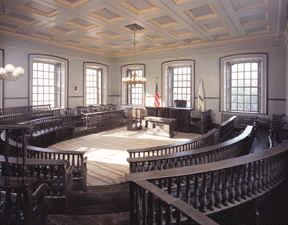The Newport Colony House is the fourth oldest statehouse still standing in the United States. It was designed by builder/architect Richard Munday, who also designed Trinity Church and the Seventh Day Baptist Meeting House in Newport. The Colony House was built between 1736 and 1739 by Benjamin Wyatt, and tradition maintains that a great number of African-Americans were employed in its construction.
The building replaced a smaller wooden courthouse built about 1687. The Colony House was constructed as part of the movement to bring formal town planning to Newport, which until then had developed in haphazard fashion. It was intended to help transform the Parade, as Washington Square was then named, into an elegant public space in keeping with the traditions of English cities. The design of the Colony House is derived from the English Georgian style popularized by the architect Sir Christopher Wren, but its floor plan follows the customary layout of English town or guild halls, which often had an open marketplace on the ground floor and civic offices on the second floor.
Many important events associated with the shaping of the United States occurred at the Colony House. In 1761, the death of George II and the ascension of George III was announced from the balcony. In 1766, citizens of Newport celebrated the repeal of the Stamp Act in and around the Colony House. In January and May of 1773, the building served as the meeting site of the Commission of Inquiry into the burning of the British revenue schooner Gaspee by Patriots in 1772. On July 20, 1776, Major John Handy read the Declaration of Independence from the front steps. During the British occupation of Newport from 1776 to 1779, the Colony House was used as a barracks.
After liberating Newport from the British, the French used the building as a hospital. It is often said that a French chaplain celebrated the first public Roman Catholic mass in Rhode Island in the Colony House, although there is no physical evidence of that. In 1781, the Great Hall on the first floor was the location of a banquet given by General Rochambeau to honor George Washington. Throughout the 19th century, the Colony House was used in May of each year for “Lection Day” festivities. On this day, the results of the Rhode Island April elections were announced, the General Assembly convened ceremonially, and officials were inaugurated. Visitors from all over Rhode Island came to Newport to participate in victory celebrations, political negotiations, and party conflicts. Newporters considered it a more important holiday than Christmas.
The Colony House served as the primary state house of Rhode Island and Providence Plantations from its completion in 1739 until 1901, when the new state house in Providence opened. From 1901 to 1926 it was the Newport County Courthouse. Between 1926 and 1932, the building was restored by architect Norman Isham, who simultaneously worked on two other nearby colonial buildings: The Brick Market and the Wanton-Lyman-Hazard House. The Colony House contains a portrait of George Washington, painted by Gilbert Stuart. In 1962, the building was designated a National Historic Landmark.
The Colony House is owned by the State of Rhode Island and managed by the Newport Historical Society.








